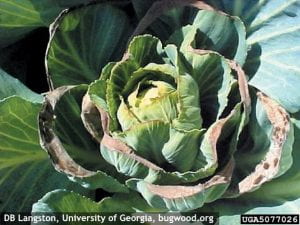May 17, 2021Treatments for tipburn in Brassica crops and lettuce outlined
Cauliflower, cabbage, Brussels sprouts, Chinese cabbage (Napa cabbage) and lettuce are susceptible to tipburn. This problem can cause severe economic losses.
Tipburn is a breakdown of plant tissue inside the head of cabbage, Chinese cabbage and lettuce, individual sprouts in Brussels sprouts, and on the inner wrapper leaves of cauliflower. It is a physiological disorder which is associated with an inadequate supply of calcium in the affected leaves, causing a collapse of the tissue and death of the cells.
Calcium deficiency may occur where the soil calcium is low or where there is an imbalance of nutrients in the soil along with certain weather and soil nutrient conditions, such as high humidity, low soil moisture, high potassium or high nitrogen all of which can reduce calcium availability. Secondary rot caused by bacteria can follow tipburn and heads of cauliflower can be severely affected.
Some cabbage and cauliflower cultivars are relatively free of tipburn problems. Tipburn ratings for cabbage are given in the Mid-Atlantic Commercial Vegetable Production Recommendations. Lettuce grown in high tunnels and greenhouses can also have tipburn problems. Growing conditions including high humidity, lack of air movement, and poor root system development can lead to tipburn problems in lettuce. The disorder most frequently occurs as the head is beginning to reach maturity. The inner part of the head has locally humid conditions and less airflow due to the presence of the outer, wrapper leaves.

Tipburn in greenhouse lettuce.
Controlling tipburn starts with managing liming so that soil pH is above 6.0. Limit ammonium forms of nitrogen and ensure an adequate and even supply of water. Adjust planting date so that head maturation occurs during cooler temperatures. Plant a cultivar that is less susceptible to the disorder.
In hydroponic growing systems, maintain calcium levels in growing solutions at 90 ppm and have good air circulation. In general, calcium foliar sprays have not been shown to be effective for controlling tipburn incidence.
– Gordon Johnson, Extension Vegetable & Fruit Specialist, University of Delaware

















